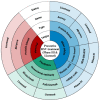Host Responses to Respiratory Syncytial Virus Infection
- PMID: 37896776
- PMCID: PMC10611157
- DOI: 10.3390/v15101999
Host Responses to Respiratory Syncytial Virus Infection
Abstract
Respiratory syncytial virus (RSV) infections are a constant public health problem, especially in infants and older adults. Virtually all children will have been infected with RSV by the age of two, and reinfections are common throughout life. Since antigenic variation, which is frequently observed among other respiratory viruses such as SARS-CoV-2 or influenza viruses, can only be observed for RSV to a limited extent, reinfections may result from short-term or incomplete immunity. After decades of research, two RSV vaccines were approved to prevent lower respiratory tract infections in older adults. Recently, the FDA approved a vaccine for active vaccination of pregnant women to prevent severe RSV disease in infants during their first RSV season. This review focuses on the host response to RSV infections mediated by epithelial cells as the first physical barrier, followed by responses of the innate and adaptive immune systems. We address possible RSV-mediated immunomodulatory and pathogenic mechanisms during infections and discuss the current vaccine candidates and alternative treatment options.
Keywords: adaptive immunity; immune evasion; immunopathology; innate immunity; respiratory syncytial virus; vaccines.
Conflict of interest statement
The authors declare no conflict of interest.
Figures




References
Publication types
MeSH terms
Substances
LinkOut - more resources
Full Text Sources
Medical
Miscellaneous

